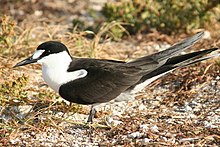Sooty tern
| Sooty tern | |
|---|---|
 |
|
| Onychoprion fuscatus nubilosus (or O. f. oahuensis) on Tern Island (French Frigate Shoals) | |
| Scientific classification | |
| Kingdom: | Animalia |
| Phylum: | Chordata |
| Class: | Aves |
| Order: | Charadriiformes |
| Suborder: | Lari |
| Family: | Sternidae |
| Genus: | Onychoprion |
| Species: | O. fuscatus |
| Binomial name | |
|
Onychoprion fuscatus (Linnaeus, 1766) |
|
| Subspecies | |
|
2-9, see text |
|
| Synonyms | |
|
Onychoprion fuscata (lapsus) |
|
2-9, see text
Onychoprion fuscata (lapsus)
Sterna fuscata Linnaeus, 1766
Sterna fuscata fuscata Linnaeus, 1766
Sterna fuscata nubilosa
and see text
The sooty tern (Onychoprion fuscatus) (formerly Sterna fuscata), is a seabird of the tern family, (Sternidae). The genus name is from Ancient Greek onux, "claw", and "prion", nail. The specific fuscatus is Latin for "dark".
It is a bird of the tropical oceans, breeding on islands throughout the equatorial zone. Colloquially, it is known as the wideawake tern or just wideawake. This refers to the incessant calls produced by a colony of these birds, as does the Hawaiian name ʻewa ʻewa which roughly means "cacophony". In most of Polynesia its name is manutara or similar however – literally "tern-bird", though it might be better rendered in English as "the tern" or "common tern". This refers to the fact that wherever Polynesian seafarers went on their long voyages, they usually would find these birds in astounding numbers. It is also known as kaveka in the Marquesas Islands, where dishes using its eggs are a delicacy.
This is a large tern, similar in size to the Sandwich tern (Thalasseus sandvicensis) at 33–36 cm (13–14 in) long with an 82–94 cm (32.5–37 in) wingspan. The wings and deeply forked tail are long, and it has dark black upperparts and white underparts. It has black legs and bill. The average life span is 32 years. Juvenile Sooty Terns are scaly grey above and below. The Sooty Tern is unlikely to be confused with any tern apart from the similarly dark-backed but smaller bridled tern (O. anaethetus). It is darker-backed than that species, and has a broader white forehead and no pale neck collar.
...
Wikipedia

